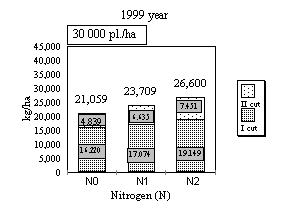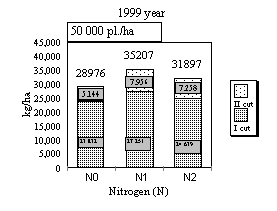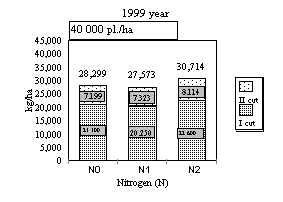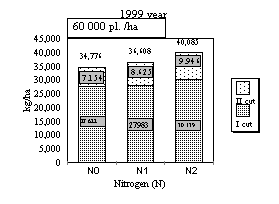 |
 |
The influence of plant density, (30.000, 40.000, 50.000, and 60.000 plants per hectare) and three doses of nitrogen fertilizer (N0 = without N, N1 = 100 kg N/ha, and N2 = 200 kg N/ha) on the yield and quality of sage (Salvia officinalis L.) were tested in the field experiment.
Two cuts per year were attained in both experimental years. The average yield in the first year was 14.939 kg/ha of fresh matter (F.M), wherein 38.6% was attained in the first cut, and 61.4% in the second one. The portion of dry leaves and dry stalk in the total fresh matter was 16.5 %, and 10.8 %, respectively.
The yield of FM in the first year varied from 12.780 kg/ha (at 30.000 p/ha) to 17.023 kg/ha FM (at 60.000 p/ha). Statistically significant increment was reached at plant density of 40-, 50-, and 60.000 p/ha comparing with 30.000 p/ha, and at 60.000 comparing with 30-, 40- and 50.000 p/ha. Statistically significant difference in the yield between plant density 40.000, and 50.000 p/ha was not obtained in the first year. The total annual yield in the second year was as follows: at plant density 30.000 p/ha = 23.789 kg/ha, at 40.000 p/ha = 28.862 kg/ha, at 50.000 p/ha = 32.026 kg/ha, at 60.000 p/ha = 37.156 kg/ha FM, with statistically significant differences between all variants of plant densities.
Fertilizing with nitrogen (N) did not have an influence on the yield of sage in first experimental year, when it was 14.408 - 15251 - 15.158 kg/ha FM at N0 - N1 - N2, respectively, but in the second year the yield at N2 (32.324) was significantly higher than at N0 (28.277 kg/ha FM).
Concerning interaction of two tested factors, in the first year the lowest yield was attained at 30.000 x N0 combination (12.016 kg/ha), and the highest at 60.000 xN1 combination (17.861 kg/ha FM). The lowest yield in the second year was at 30.000 xN0 combination (21.059 kg/ha), and the highest at 60.000 x N2 combination (40.085 kg/ha FM).
The essential oil content in dry leaves of sage at different plant densities varied from 1.60 to 1.69% in the first cut, and from 0,92 - 1,09% in the second one, in the first year of investigation. Significant differences in the essential oil content between different plant densities and different nitrogen doses was not obtained in first year.
Key words: Salvia officinalis L., cultivation, plant density, nitrogen fertiliziation, yield, essential oil content
Garden sage (Salvia officinalis L.) takes very important place in a global market of medicinal plants. The market prefers to consume only the standard quality raw material. The supplying of sufficient quantities of sage raw material is possible only trough development of plantation production.
Sage is a hardy plant and can withstand dry conditions. However, like most crops, its productivity can be substantially improved by good management. An influence of environmental factors and fertilization on sage yield and quality is often discussed in a literature (Piccaglia and Maroti 1989 and 1993: Rohricht et al. 1996). The problem of optimal plant densities in interaction with nitrogen fertilization in plantation production of sage is poorly studied.
The aim of this research was to improve the knowledge of influence of plant densities and N fertilization on the yield and quality of sage in continental climatic conditions. Only the results concerning yield of sage and essential oil content are shown in this paper.
Field experiments were carried out during 1998 and 1999, with species Salvia officinalis L, cultivar Primorska. Soil Type: Humogley, pH(KCl) = 5.7; humus content 3.8%, P2O5 = 12 mg/100 g., K2O = 38 mg/100 g., content of sand 5%, silt 46%, clay 49%. Locality: Pančevo, South Banat, Yugoslavia, 70 m a.s.l, continental type of climate, annual mean temperature 11.3oC; total annual precipitation 613 mm. Experimental factors were: Plant density, 30 000, 40 000, 50 000, 60 000 plants per hectare (pl./ha), and nitrogen (N) fertilising, N0 = 0 kg/ha, N1 = 100 kg/ha, N2 = 200 kg/ha. Basal dressing was (kg/ha) P2O5= 100, K2O =100. The "split - splot" experimental design, in 4 replication was used. Plot size was 7.5-12.5 m2, depending on the rows and plant distance. The nursery plants were planting at the beginning of April 1998. Sage was grown as a perennial crop. Weed control was performed by mechanisation between rows, and manually within the rows. The dates of harvest in the first year were: I cut - July 28, 1998, II cut - October 19, 1998, and in the second one: I cut - July 20, 1999, II cut - October 26, 1999. Sage plants were harvested manually by cutting down at 8-10 cm from the ground.
Laboratory: Samples were dried at room temperature. The one kilo of fresh plant material per each experimental plots was dried and used in determination leaf - stem ratio. Essential oil content was determined in air-dried leafs by hydrodistillation in a Clevenger type apparatus for 2 hours according to the European Pharmacopoeia method.
Yield of aerial part of sage
Yields are shown in kilos of fresh matter (FM) of aerial part of sage per hectare.
First year
In the experiment established in the spring 1998 two harvests were achieved already in the first year. Total annual yield of sage in the first year was in the range from 12 - 17 t/ha of FM. The yield was lower in the first cut than in the second, since the plants were only 3 moths old in July 1998. The yield in first cut was on the level of 35-40 % from total annual yield in the first year (Graph 2). The sage was irrigated after first cut and its development was very successful during August and September 1998. The yield in the second cut was significantly higher compared with the yield in the first cut (Graph 2). Piccaglia and Marotti (1989) obtained 12-14 t/ha yield of sage plant material in trial carried out in the conditions of north Italy, in the first year of cultivation.
 |
 |
Plant density had very significant influence on the sage yield in the first year of the investigation. The lowest average annual yield of FM was at 30.000 pl./ha - 12.7 t/ha, and the highest at 60.000 pl./ha - 17 t/ha. Statistically significant increase was reached at plant density of 40.000, 50.000, and 60.000 pl/ha, comparing with 30.000 pl/ha, and at 60.000, comparing with 30.000, 40.000 and 50.000 pl/ha. Statistically significant difference in the yield between plant density 40.000, and 50.000 p/ha was not obtained in the first year.
The fertilization with nitrogen had weak influence on the increment of sage yield in the first year (Graph 1). The average increase of the sage yield that has been achieved at N1 dose (15.3 t/ha), comparing with N0 dose (14,4 t/ha) was not statistically significant. The yield of sage in the first experimental year at N0 - N1 - N2 doses was 14 408 - 15 251 - 15 158 kg/ha FM, respectively.
Influence of interactions "plant density x N fertilization" on sage yield in the first year is shown in graph 2. The lowest yield 12.016 kg/ha (FM) was obtained for the combination "30.000 pl./ha x N0", and the highest 17.761 kg/ha at combination "60.000 pl./ha x N1".
Second year
In the second year of investigation (1999) yield of sage were much higher than in first one. The average increase of yields was in the range from 86-87%, at plant density 30.000 and 40.000 pl./ha, to 118-120 % at plant density 50.000 and 60.000 pl./ha (Graph 1). The total annual yield in the second year was as follows: at plant density 30.000 pl./ha = 23.789 kg/ha, at 40.000 pl./ha = 28.862 kg/ha, at 50.000 pl./ha = 32.026 kg/ha, at 60.000 pl./ha = 37.156 kg/ha FM, with statistically significant differences between all plant densities.
 |
 |
 |
 |
 |
 |
 |
 |
The influence of nitrogen (N) fertilizing on the yield of sage was expressed in the second year of the experiment, when the yield at N2 (32.324) was significantly higher than at N0 (28.277 kg/ha FM).
Röhricht et al. (1996) in the experiments with plants density of 32.000 pl./ha (0.9 x 0.35 m) achieved significant yield increase by application of 100 kg N/ha in comparison with variant without N fertilization, but only in the second year of investigation.
Concerning interaction of two tested factors, in the second year the lowest yield was achieved at combination 30.000 pl./ha x N0 (21.059 kg FM/ha), and the highest at combination 60.000 pl./ha x N2 (40.085 kg FM/ha).

Hibernation of the sage during the winter 1998/99
Losses of the sage plants caused by freezing during the winter 1998/99 were very variable on the experimental plots. They ranged from 0,0 - 25,7 % on experimental parcels. Average data show a certain tendency of increment of such losses with the increase of plant density and nitrogen doses (Tab. 1.). However, these results are not statistically significant! The variability of individual data was probably caused by numerous other factors. Some of these factors could be: later second harvest in 1998 (October 19th), and very cold December 1998.
|
|
|
||||||
|
|
|
|
|
|
|
|
|
|
|
|
|
|
|
|
|
|
|
|
|
|
|
|
|
|
|
Quality of sage plant material
Portion of dry leaf in the fresh matter of sage was very variable and depend more on the harvest season, than on the tested experimental factors. Average portion of dry leaf in the total yield varied from 16.5-26.2% (Graph 4).
Essential oil content
The content of essential oil in dry sage leafs (table 2.) varied in the wide range 0.79-2.08% in two experimental years. It can be said that tested experimental factors in this investigation had a small influence on essential oil content in sage. Percentage of essential oil in sage leaf varied, depending on the harvest season, and on the year. In the first year, content of essential oil was significantly higher in the first harvest than in the second one, and this tendency was very clear and obtained for all experimental variants (tab 2). In the second year variability of individual data was much higher than in the first one, and there were no clear differences in essential oil content between harvest seasons or experimental factors.
The portion of active components in essential oil of sage in this investigation isn't included in this paper. They will be discussed in one of the future works.
|
|
|
||||||
|
|
|
|
|
|
|
|
|
|
|
|
|
|
|
|
|
|
|
|
|
|
|
|
|
|
|
|
|
|
|
|
|
|
|
|
|
|
|
|
|
|
|
|
|
|
|
|
|
|
|
|
|
|
|
|
|
|
|
|
|
|
|
|
|
|
|
|
|
|
|
|
|
|
|
|
|
|
|
|
|
|
|
|
|
|
|
|
|
|
|
|
|
|
|
|
|
|
|
|
|
|
|
|
|
|
|
|
|
|
|
|
|
|
|
|
|
Piccaglia R., and Marotti M. (1989): Effect of mineral fertilizers on the composition of Salvia officinalis L. oil, J. Ess. Oil Res., 2, 73-83.
Piccaglia R., and Marotti M. (1993): Characterisation of several aromatic plants grown in northern Italy, Flavour Fragr. J., 8, 115 - 122
Röhricht Chr., Grunert M., Solf M. (1996): Der einfluss einer gestaffelten Stickstoff-düngung auf ertrag und qualität von Echtem Salbei (Salvia officinalis L.), Arznei- und Gewürzpflanzen, 1, 117-122.
Škorić A. (1986): Postanak razvoj i sistematika tala, (Genesis development and classification of soil), FPZ, Zagreb.